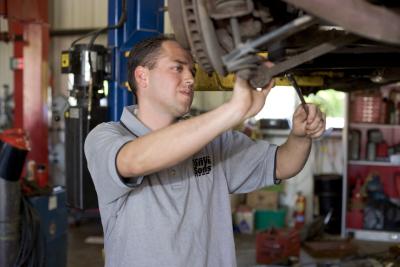
Shock absorbers are installed on your car's suspension to dampen shock and stabilize the ride when going over bumps or rough roads. Most cars have a shock absorber for each wheel. Although shock absorbers, or shocks, don't support the weight of the vehicle, they control the oscillation of the suspension over rough surfaces, keeping the tires in full contact with the road at all times. Over time, shock absorbers wear out and need replacement.
Road test your car on a familiar road and note any differences in the usual ride and handling. Listen for squeaks in the suspension that may indicate worn shock absorber bushings. Note that any of the following symptoms may point to worn shock absorbers: bounciness in the ride, tires squealing around corners or hydroplaning on wet roads.
Park the car on a level surface. Push down on the bumper or fender on one corner of the car. Stand back and allow the body to rise back up. If the body bounces more than once, the shock absorber on that corner of the car may be worn. Repeat this procedure for the other three corners of the car to check the other shocks.
Crawl under the vehicle and visually inspect the shock absorbers for leaking oil. Check the shock mounting brackets and bolts to ensure that they are not loose or broken. Check for excessive corrosion or deformation in the shock body, which would warrant replacement of the shocks.
Check the tread on the tires for patchy wear or worn spots, which would indicate the wheel is not staying in complete contact with the road over bumps because of worn shocks.
Have the shock absorbers tested by your auto mechanic using a dynamometric test machine. Have the shocks replaced if they fail the test.